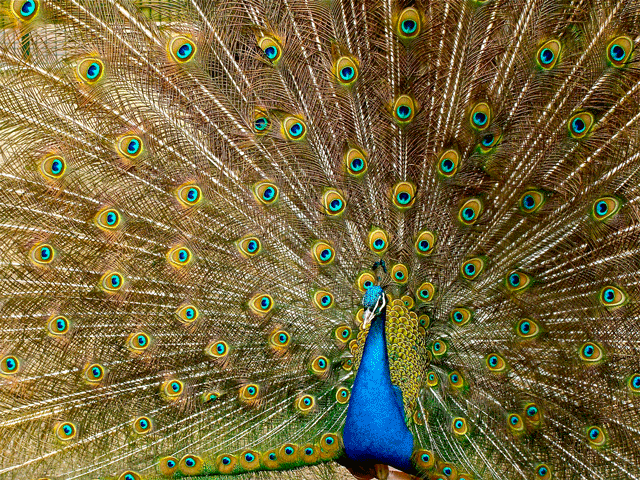Science Note: Turning up the volume on the mating dance
Air Date: Week of August 24, 2012

A male peacock struts with his eye-spotted plumage held high. (Photo: Jebulon/ Wikipedia)
The peacock is notorious for its unique mating display, where it raises up its ornate eye-spotted tail and shakes. Now, new research tells us humans can't quite experience the full show. Christy Perera reports.
Transcript
CURWOOD: The peacock is known for its beautiful plumage and elegant mating dance. New research shows there's more to the dance than meets the human ear.
[SCIENCE NOTE THEME]
PERERA: During the mating season, male peacocks grow a long, elaborate train of feathers. They raise this massive collection of plumage upright and shimmy to attract a mate. To the human ear, this sounds similar to rustling leaves. But researchers at the University of Manitoba found that peacocks actually produce other low-pitched sounds during the dance. These noises, called thrums, fall below 20 Hertz and can't be detected by humans.
Male peacocks create two kinds of thrums--the 'pulse train' and the 'shiver train.'
The 'pulse train' starts at the base of the train feathers and summons females close by. Peacocks create the 'shiver train' by shaking their center feathers and use this to signal potential mates further away.
These brightly feathered birds are the first avian species known to create and respond to sounds below the range of human hearing. Only one other species, a member of the grouse family, has been recorded creating infrasounds like these thrums. But those grouse didn't react to recordings of infrasound, so it's unlikely they use the sounds for communication.
Biologists suspect that if peacocks can rumble, other birds can too. And thanks to this research, it's clear the mating dance is music to a bird's ears.
That's this week's note on emerging science. I'm Christy Perera.
Links
The University of Manitoba studied the mating sounds of peacocks
Living on Earth wants to hear from you!
Living on Earth
62 Calef Highway, Suite 212
Lee, NH 03861
Telephone: 617-287-4121
E-mail: comments@loe.org
Newsletter [Click here]
Donate to Living on Earth!
Living on Earth is an independent media program and relies entirely on contributions from listeners and institutions supporting public service. Please donate now to preserve an independent environmental voice.
NewsletterLiving on Earth offers a weekly delivery of the show's rundown to your mailbox. Sign up for our newsletter today!
 Sailors For The Sea: Be the change you want to sea.
Sailors For The Sea: Be the change you want to sea.
 The Grantham Foundation for the Protection of the Environment: Committed to protecting and improving the health of the global environment.
The Grantham Foundation for the Protection of the Environment: Committed to protecting and improving the health of the global environment.
 Contribute to Living on Earth and receive, as our gift to you, an archival print of one of Mark Seth Lender's extraordinary wildlife photographs. Follow the link to see Mark's current collection of photographs.
Contribute to Living on Earth and receive, as our gift to you, an archival print of one of Mark Seth Lender's extraordinary wildlife photographs. Follow the link to see Mark's current collection of photographs.
 Buy a signed copy of Mark Seth Lender's book Smeagull the Seagull & support Living on Earth
Buy a signed copy of Mark Seth Lender's book Smeagull the Seagull & support Living on Earth

